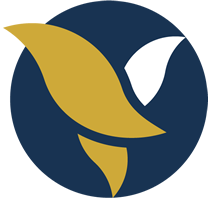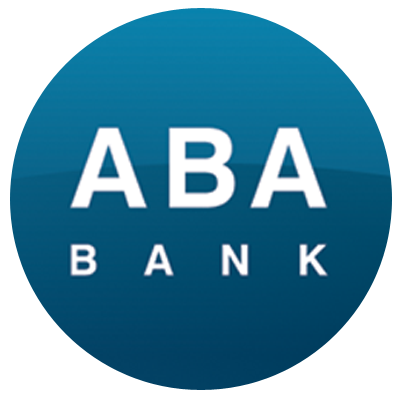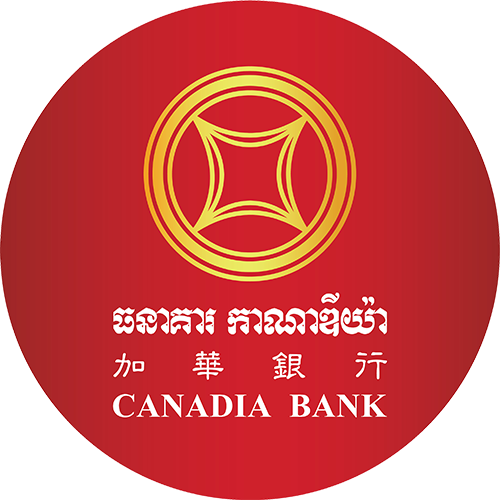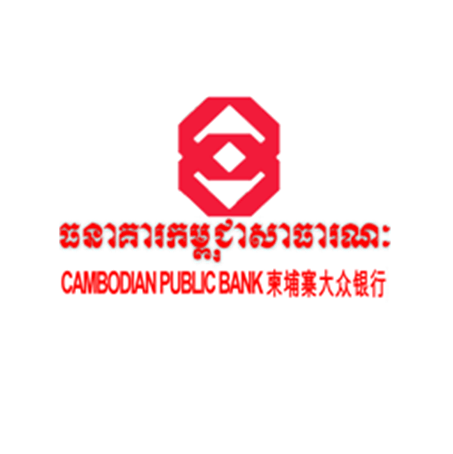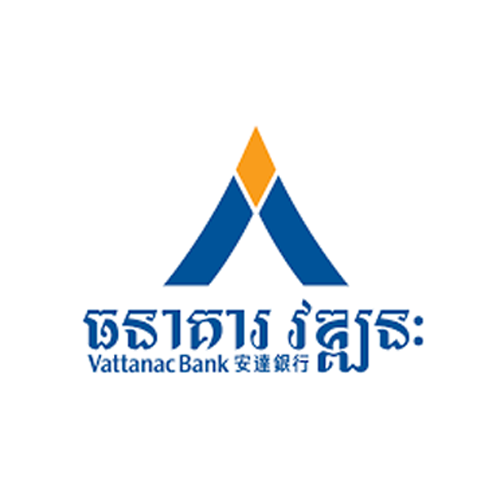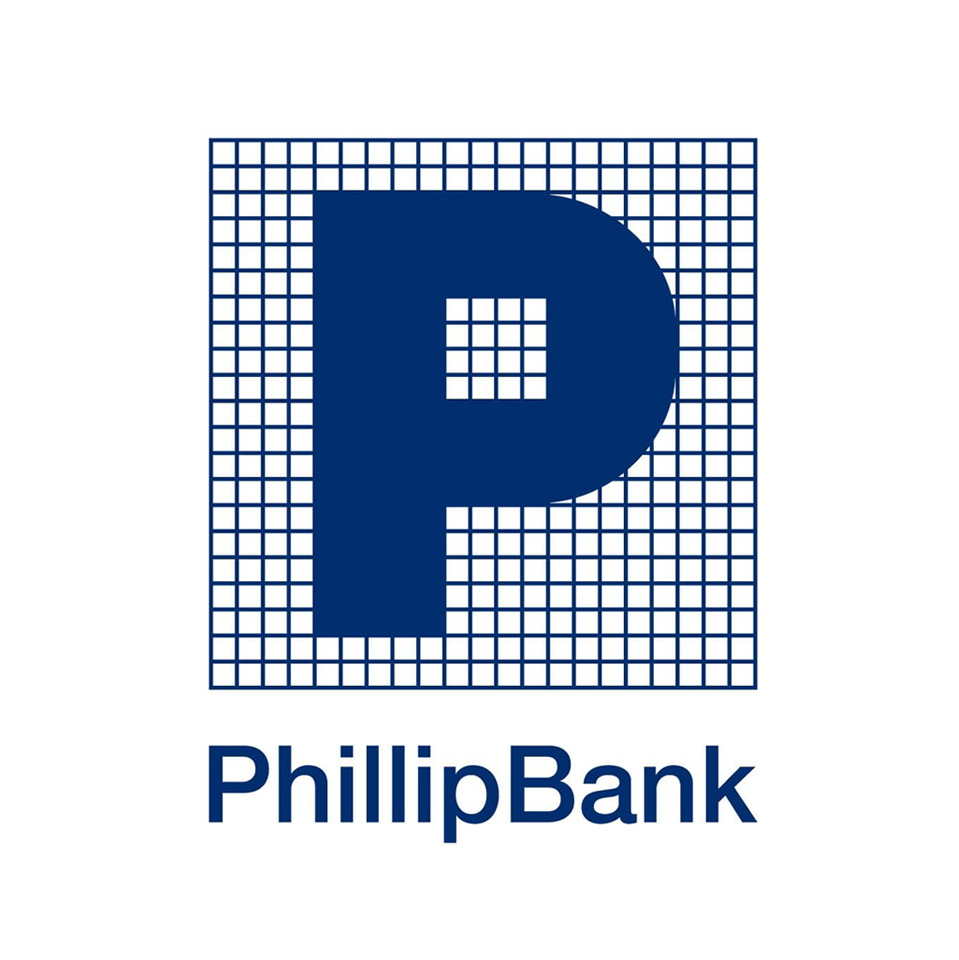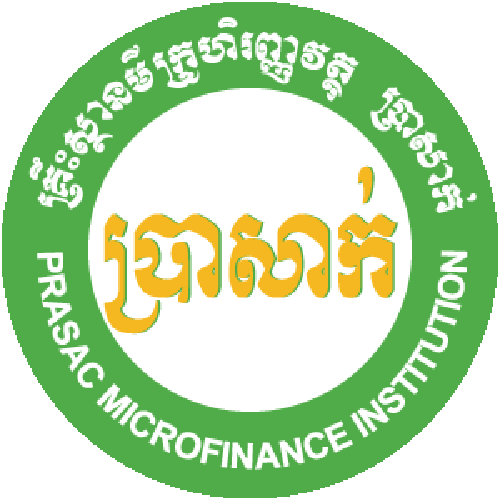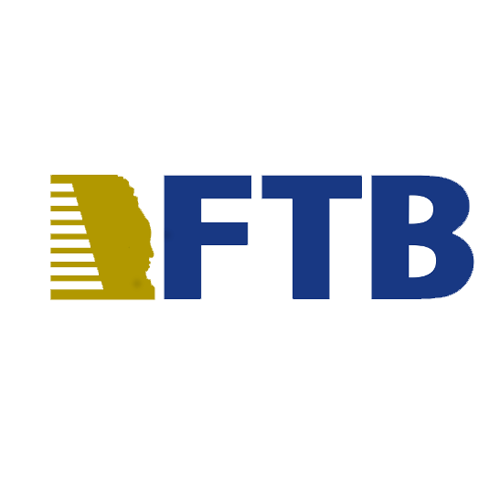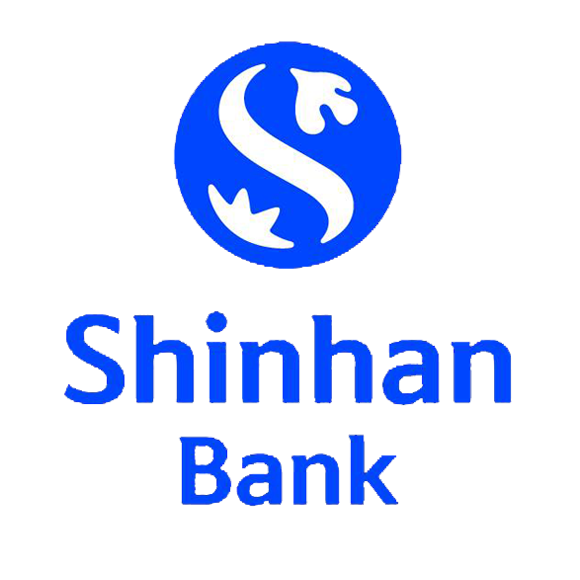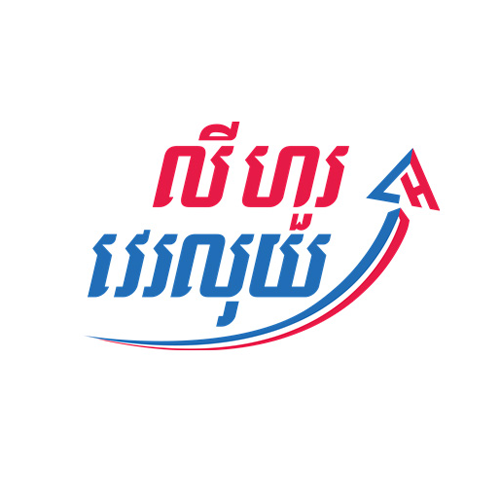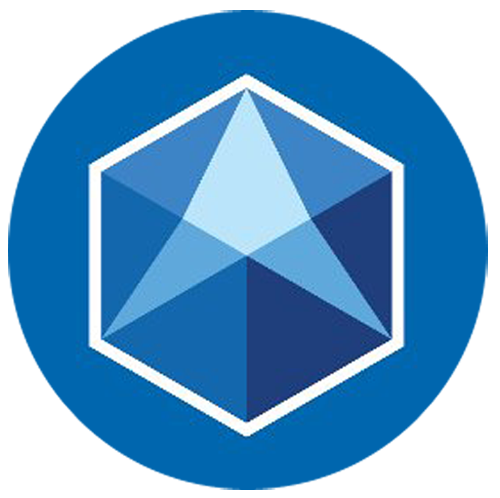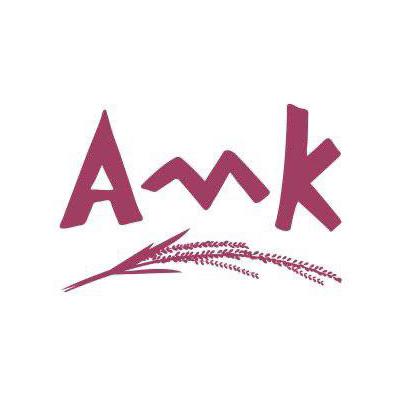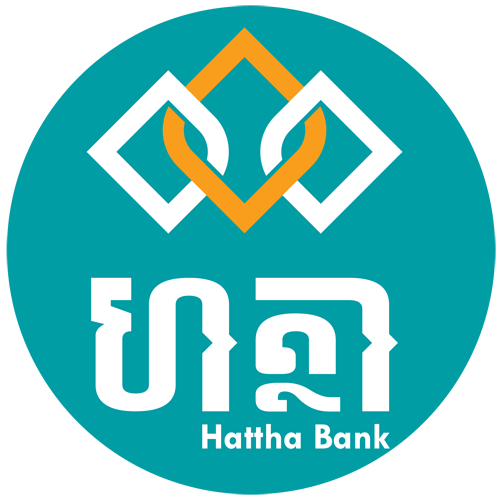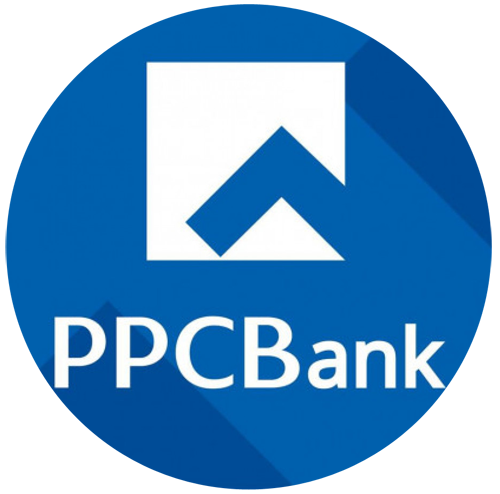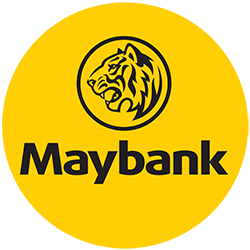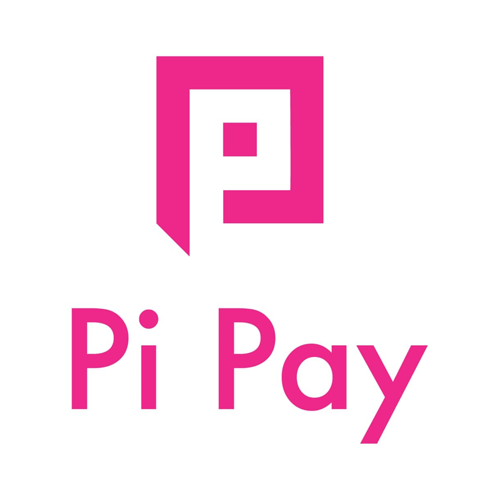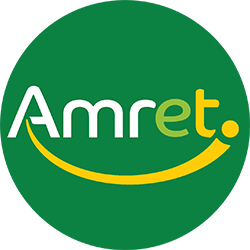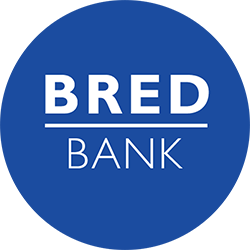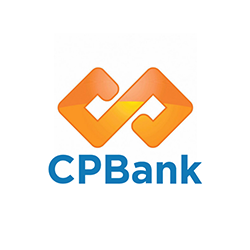 Acknowledgements
Acknowledgements
This publication has been possible due to the support and efforts of various organizations and
people. We would like to take this opportunity to thank the Ministry for Foreign Affairs of Finland
for supporting the Mekong Water Dialogues; PPWSA and all its staff members for spending
precious time sharing details about their works; IUCN-Asia Regional and Cambodia Office
especially to Michael Dougherty, Robert Mather, Sarah Turner, Kim Kong Sreng, Sum Touch and
Lisa B Idris. A special thanks to Theavy Keo for helping with interviews in Phnom Penh.
Photographs for this publication were contributed by Ganesh Panagare, Binayak Das and
PPWSA.
Learning from the Phnom Penh Water Supply Authority (PPWSA)
Binayak Das, Ek Sonn Chan, Chea Visoth, Ganesh Pangare, and Robin Simpson

Credits
The designation of geographical entities in this publication and the presentation of the material do not imply the expression of any opinion whatsoever on the part of IUCN, The Ministry for Foreign Affairs of Finland or the Phnom Penh Water Supply Authority (PPWSA) concerning the legal status of any country, territory, or area, or of its authorities, or concerning the delimitation of its frontiers or boundaries.
The views expressed in this publication do not necessarily reflect those of IUCN, The Ministry for Foreign Affairs of Finland or the PPWSA.
This is a joint publication by IUCN and PPWSA where learnings from the reform process undertaken by the Phnom Penh Water Supply Authority are shared for the Mekong Water Dialogues Program, facilitated by IUCN. No warranty as to the accuracy or completeness of this information is given, and no responsibility is accepted by IUCN or its employees for any loss or damage arising from reliance on the information provided.
This publication has been made possible in part by the generous support of The Ministry for Foreign Affairs of Finland.
Published by: IUCN, Gland, Switzerland and Bangkok, Thailand and PPWSA, Phnom Penh, Cambodia
Copyright: © 2010, International Union for Conservation of Nature and Natural Resources
Reproduction of this publication for educational or other non-commercial purposes is authorized without written permission from the copyright holder provided the source is fully acknowledged. Reproduction of this publication for resale or other commercial purposes is prohibited without prior written permission of the copyright holder.
Citation: Binayak Das, Ek Sonn Chan, Chea Visoth, Ganesh Pangare, and Robin Simpson (2010), eds. Sharing the Reforms Process, Mekong Water Dialogue Publication No. 4, Gland, Switzerland: IUCN. 58pp.
ISBN: 978-2-8317-1289-5
Photographs: Ganesh Pangare, Binayak Das and PPWSA
Cover: Michael Dougherty
Layout by: Keen Media (Thailand) Co., Ltd.
Produced by: IUCN Asia Regional Water and Wetlands Programme
Funded by: The Ministry for Foreign Affairs of Finland and IUCN
Available from:
Coordinator
Asia Regional Water and Wetlands Programme
IUCN Asia Regional Office
63 Sukhumvit Road Soi 39
Wattana, Bangkok 10110 Thailand
Telephone + 66 2 662 4029
Email: asia@iucn.org
Website: www.iucn.org/asia

1 | Water Utilities in Asia: Status and Successes
 1.1 Inefficiency galore
1.1 Inefficiency galore
Wise use and good management of water resources is an important requisite to ensure environmental
sustainability. This factor is often not correlated to management of urban water supply systems especially
in the developing world of Asia, Africa and Latin America, where poor management leads to inefficient water
usage, water loss and degradation of water quality, which in turn affects the environment. Many developing
countries have continued to be beleaguered by inefficient water utilities that have been performing poorly
for a long time. Ever-increasing urban populations have generally overwhelmed the limited management
capacities and resources of water utilities at all levels. Unplanned and poorly managed urbanization
processes have been an important source of social and environmental stress in all developing countries.
Urban water problems in developing world cities such as those in South East Asia are viewed as the consequences of rapid and uncontrolled urbanization and unsustainable development. The pursuit of economic advancement had conjured a disregard for environmental conservation, which in turn has resulted in water problems of considerable magnitude. Many of the Asian cities' publicly managed water utilities perform below their potential. Urban water management in Asian cities is plagued by a myriad set of problems.
It is estimated that 40% of the population of Asian cities with a population of more than a million, mainly the poor, do not have access to piped water (See Table 1: Piped Water Coverage – Asian Cities). Less than 60% of the population has access to piped water in Delhi, Dhaka, Jakarta and Manila. Many consumers, due to lack of coverage, have to go to informal sector vendors for their water needs, often at a considerable expense and the quality of the water is suspect. For instance, in Manila, people pay 5 USD per cubic metre (m³) for buying water from a vendor, while piped water costs 0.10 USD/m³ – a differential of 50. Only 30% of Asian cities have 24-hour water supply. The rapid onset of urbanization has made urban water management a priority area in order to avoid large scale collapses.
Table 1 : Piped water coverage – Asian Cities (based on connections)
Source: McIntosh A 2003, Asian Water Supplies-Reaching Urban Poor, Asian Development Bank and International Water Association
Some of the major causes for the inefficient services with enormous losses in terms of water and revenue are due to a multitude of vicious cyclic factors, which include poor management and political interference. The utilities are mostly bankrupt and are dependent on government doles to function. The political class in many Asian cities uses water as a vote bank tool and is not willing to undertake tariff reforms. Corruption is also high, as the political class want to protect their power base and access to funds. The lack of reforms leaves the utilities short of adequate revenue to invest in creating assets and in operations and maintenance (O&M) of the utilities. These results in having a utility that fails to deliver effective quality service. Quality of construction is poor, and O&M works take a long period time for completion. Water supply is intermittent as the distribution network is extended beyond hydraulic potential due to political one-upmanship. Illegal connections are high in number as they fetch bribes to employees, and this in turn leads to low water pressure. High non-revenue water (NRW) and low accountability arose from these illegal connections along with lack of appropriate metering, inadequate billing and leakages in networks due to poor maintenance
(See Chart 1: Non-revenue in Asian cities -2001).
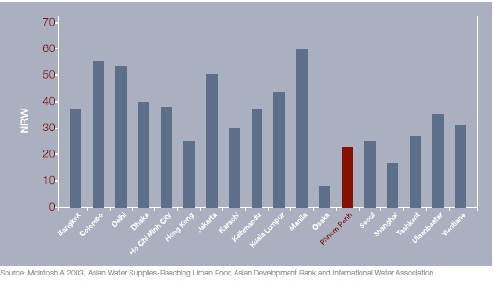
Another key factor that is responsible for this undesirable situation of water utilities is inefficient management and lack of skilled personnel. Historically, Asian water utilities have been managed by civil servants. Civil servants' rules, however, are bureaucratic, outdated, and suppress transparency. Civil servants are promoted according to rank and seniority and may lack the adequate skills for management. Engineers dominate water utilities and specialists for finances and management are missing. Most of the water utilities are overstaffed and under-skilled. Nepotism and interference from politicians and powerful people leads to recruiting of unskilled people as a water utility is a source of job creation. Also, the lack of awareness among consumers allows the utility operators to run it according to their whims and fancies with no accountability. Lack of autonomy is hampering reforms within water utilities.
1.2 A few successes Given the poor status of public water utilities, critics have argued that private sector participation can lead
to better management; but due to a variety of factors and controversies, private participation did not take
off or bring any major changes. In the meantime, some of the public water utilities in the developing world
initiated reforms with support from the government and donors agencies. Over a period of time, some of the public water utilities' reform processes met with
successproving that sincere and committed reforms
within the water utilities with political, governmental
and donor support can bring major improvements.
Allowing autonomy to the water utilities with
adequate financial support and good leadership
can improve the performance of these utilities and
also make them financially sustainable. Some of the
examples of better management include the water
utilities of the Brazilian city, Porto Alegre; the capital of
Uganda, Kampala; the Bolivian city of Cochabamba
that went through major water riots1; and the
Cambodian capital of Phnom Penh, which also
recovered from an intense period of genocide and
civil war.
Given the poor status of public water utilities, critics have argued that private sector participation can lead
to better management; but due to a variety of factors and controversies, private participation did not take
off or bring any major changes. In the meantime, some of the public water utilities in the developing world
initiated reforms with support from the government and donors agencies. Over a period of time, some of the public water utilities' reform processes met with
successproving that sincere and committed reforms
within the water utilities with political, governmental
and donor support can bring major improvements.
Allowing autonomy to the water utilities with
adequate financial support and good leadership
can improve the performance of these utilities and
also make them financially sustainable. Some of the
examples of better management include the water
utilities of the Brazilian city, Porto Alegre; the capital of
Uganda, Kampala; the Bolivian city of Cochabamba
that went through major water riots1; and the
Cambodian capital of Phnom Penh, which also
recovered from an intense period of genocide and
civil war.
 In Porto Alegre, Departamento Municipal de Água
e Esgotos (DMAE) is a publicly owned water utility
which focuses on social inclusion and has been
able to achieve tremendous amount of success
in involving local communities in the city's water
management. Tariffs play an important role, and
DMAE set the sanitary infrastructure with the utility's
own revenue.
In Porto Alegre, Departamento Municipal de Água
e Esgotos (DMAE) is a publicly owned water utility
which focuses on social inclusion and has been
able to achieve tremendous amount of success
in involving local communities in the city's water
management. Tariffs play an important role, and
DMAE set the sanitary infrastructure with the utility's
own revenue.
Similarly, the National Water and Sewerage
Corporation (NWSC) of Kampala has achieved a
high degree of success since it undertook reforms.
NWSC had a strong infrastructure, water resources
and a legal framework but was lacking an efficient
labour force, had high NRW and poor service,
among other drawbacks. After reform, the service
coverage increased from 48% to 70%, NRW was
reduced by 20%, and the utility went from loss to
profit in a span of eight years, generating 34 million
USD.
1.3 Phnom Penh's success story
 In the same league is Cambodia's Phnom Penh Water Supply Authority (PPWSA), which suffered from the
problems familiar to many other Asian water utilities. This publication focuses on the Phnom Penh reforms,
which are exemplary in nature. After the country's virtual destruction during the mid 1970s by the Khmer
Rouge regime, attempts at recovery during the 1980s were hampered by international trade sanctions until
1993. PPWSA faced an extreme situation, and this makes the story of recovery even more remarkable. The
service was plagued with the same maladies of inefficient service, high NRW, poor coverage and financial
losses. PPWSA undertook major reforms and transformed a war-ravaged water utility into a commendable
model.
In the same league is Cambodia's Phnom Penh Water Supply Authority (PPWSA), which suffered from the
problems familiar to many other Asian water utilities. This publication focuses on the Phnom Penh reforms,
which are exemplary in nature. After the country's virtual destruction during the mid 1970s by the Khmer
Rouge regime, attempts at recovery during the 1980s were hampered by international trade sanctions until
1993. PPWSA faced an extreme situation, and this makes the story of recovery even more remarkable. The
service was plagued with the same maladies of inefficient service, high NRW, poor coverage and financial
losses. PPWSA undertook major reforms and transformed a war-ravaged water utility into a commendable
model.
 Over a period of 15 years, PPWSA went through major changes that catapulted the water utility into one
of the more successful water service providers. The results and achievement have been exemplary, and it
has not stopped with that; PPWSA is continuously evolving, expanding and introducing newer processes.
There have been overall reforms within PPWSA, with new processes being introduced in various
departments that helped to bring about the changes. The water authority was granted autonomous
status with independent management. Political support for the reform process came with the Prime Minister
giving full support, and available funds – in the form of grants and loans from various multi-lateral agencies
– created the enabling environment. Peace and stability within the country also helped PPWSA. A skilled
set of enthusiastic employees and a leader with vision and a focused commitment helped to change the
functioning of PPWSA, leading to improved service provision for all consumers across the social spectrum.
Over a period of 15 years, PPWSA went through major changes that catapulted the water utility into one
of the more successful water service providers. The results and achievement have been exemplary, and it
has not stopped with that; PPWSA is continuously evolving, expanding and introducing newer processes.
There have been overall reforms within PPWSA, with new processes being introduced in various
departments that helped to bring about the changes. The water authority was granted autonomous
status with independent management. Political support for the reform process came with the Prime Minister
giving full support, and available funds – in the form of grants and loans from various multi-lateral agencies
– created the enabling environment. Peace and stability within the country also helped PPWSA. A skilled
set of enthusiastic employees and a leader with vision and a focused commitment helped to change the
functioning of PPWSA, leading to improved service provision for all consumers across the social spectrum.
 The change of guard in the Phnom Penh Water Supply Authority (PPWSA) was an
important factor that triggered the reform process. In 1993, Ek Sonn Chan took over as
the General Director of PPWSA. With over 30 years of experience in the trade, electricity,
water supply and sanitation sectors, Ek Sonn Chan's appointment as the PPWSA head
began the utility's transformation from a decrepit and war-torn water supply system with
missing water and customers into a model public sector water utility that provides 24-
hour, safe drinking water to Phnom Penh. As the result of his hard work and excellent
management, PPWSA was rapidly rehabilitated and developed until it reached full
autonomy in December 1996. Since then, PPWSA is growing everyday and operating
with full cost recovery. The task has not been easy, and Ek Sonn Chan has had to deal with life-threatening
situations. When he tried to make everyone pay for their water consumption, one army officer refused and even
pointed a pistol at him, but that did not deter him and ultimately the concerned defense official was forced to pay.
Similarly, when internal reform was initiated within PPWSA, there was resistance to change and
employees tried to involve powerful figures and the media, but again he did not budge.
The change of guard in the Phnom Penh Water Supply Authority (PPWSA) was an
important factor that triggered the reform process. In 1993, Ek Sonn Chan took over as
the General Director of PPWSA. With over 30 years of experience in the trade, electricity,
water supply and sanitation sectors, Ek Sonn Chan's appointment as the PPWSA head
began the utility's transformation from a decrepit and war-torn water supply system with
missing water and customers into a model public sector water utility that provides 24-
hour, safe drinking water to Phnom Penh. As the result of his hard work and excellent
management, PPWSA was rapidly rehabilitated and developed until it reached full
autonomy in December 1996. Since then, PPWSA is growing everyday and operating
with full cost recovery. The task has not been easy, and Ek Sonn Chan has had to deal with life-threatening
situations. When he tried to make everyone pay for their water consumption, one army officer refused and even
pointed a pistol at him, but that did not deter him and ultimately the concerned defense official was forced to pay.
Similarly, when internal reform was initiated within PPWSA, there was resistance to change and
employees tried to involve powerful figures and the media, but again he did not budge.
Ek Sonn Chan is popular among his employees and gets support from them, as well as from consumers. He has
been awarded national and international awards among which are six Golden Medals from the Government of
Cambodia, 2004 Water Prize from the Asian Development Bank with the for his excellent and outstanding leadership
in the contribution to realize the MDG "Water for All," and the 2006 Roman Magsaysay Award for Government
Service for the same feat.
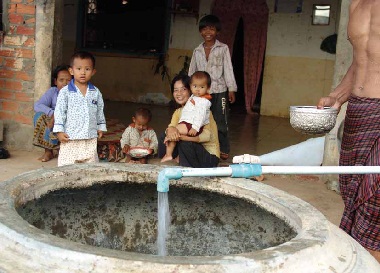
2 | Phnom Penh: The Transformation
Phnom Penh, the capital of the Kingdom of Cambodia (See Map 1: Phnom Penh), lies on the confluence of the Mekong and the Tonle and Bassac rivers. These rivers are the source of freshwater for the city's population of around 1.3 million.
2.1 PPWSA area of operationsThere are eight districts in Phnom Penh, and PPWSA has delineated them with zonal water meters installed for each zone (See Map 2: PPWSA zones). As some of the zones are big, renewal and redesign of the coverage is still ongoing. According to the 2020 Phnom Penh Master Plan, the city has an area of 513 square meters (sqm). There are four inner and four outer districts. PPWSA has 100% coverage in the inner districts, while in the outer districts (which also include peri-urban and rural areas) coverage is between 60 to 70%. Lack of roads and organizational infrastructure is hampering PPWSA's efforts to increase coverage in peri-urban areas.
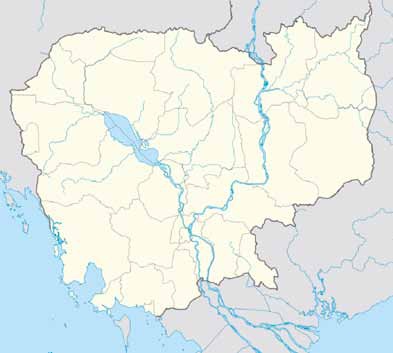
2.2 PPWSA from 1979 to 1993
 PPWSA has been catering to the city's water needs for more than 35 years. Over
time PPWSA has expanded with the
growth of the city, and by 1975, PPWSA
was producing 150,000 m3/day, with a
supply network of 282 kilometers. From
1975 to 1979, however, due to political
instabilities within the country, the
water supply system became largely
defunct, as many of its production and
distribution facilities collapsed and the
Khmer Rouge eliminated many of the
skilled employees2.
PPWSA has been catering to the city's water needs for more than 35 years. Over
time PPWSA has expanded with the
growth of the city, and by 1975, PPWSA
was producing 150,000 m3/day, with a
supply network of 282 kilometers. From
1975 to 1979, however, due to political
instabilities within the country, the
water supply system became largely
defunct, as many of its production and
distribution facilities collapsed and the
Khmer Rouge eliminated many of the
skilled employees2.
The water supply utility was made
operational again in 1979 after the
change in the political situation. The utility
managed to produce only 65,000 m3/
day, which was 45% of its initial capacity.
The lack of electricity, chemicals, funds,
and qualified personnel to undertake
proper O&M prevented the utility from
carrying out its services to full capacity.
The problem was further compounded
when the public took matters into its own hands and made thousands of illegal connections by building
underground tanks. In 1986, the water utility company was authorized to bill consumers for water supplied
within its network. It was revealed that about 26,880 customers were registered, but less than 40% actually
paid their water bills. NRW exceeded 70%, and the total revenue covered only about 50% of operational
expenditure. The distribution network was also very old. Staff were under-qualified, underpaid, unmotivated
and lacked efficiency. Nepotism was widely practiced, and discipline among the workers was low. The
billing system was also improperly documented and highly inaccurate.
Since 1993, however, a long series of transformations that started within PPWSA's top management, based on a culture of change and donor support, led to a significant turnaround (See Box 2: Result of reforms). The factors that contributed to this turnaround included investing in staff and providing incentives, promoting transparency, involving civil society, and investing in modern management procedures and technology. The top management was restructured, and dynamic younger personnel with more advanced qualifications were promoted to senior posts with more responsibilities. Senior management was given more direct responsibilities, while inefficient senior staff was moved into unimportant roles. Incentives such as higher salaries and bonuses for good performance were introduced3. However, penalties were also imposed for bad performance. There was resistance from staff in the beginning, especially by managers who used all means, including the media, to resist change. The dogged pursuit, however, of the DG and top management, as well as gains in public trust, changed the scenario. Staff members also felt a sense of ownership of the utility and took responsibility for all its operations.
The reform process initiated in 1993 and carried out over the years has dramatically improved performance (See Table 2: Then and now). Residents on average consume 160 litres/capita/day of water with a 24-7 ensured supply and metered connection. PPWSA has become profitable and is continuously increasing coverage to outer Phnom Penh. Within a 15 year timeframe, PPWSA has increased its annual water production by 437% and its distribution network by 557%. Even though people are now paying for the water they actually consume, per capita daily water consumption has nearly doubled4. The successful reforms and performance of PPWSA have received accolades and performance ratings from a wide range of agencies. In January 2004, PPWSA was awarded the ADB's Water Prize – an award conferred upon exemplary project agencies that have established sound practices in implementing ADB's "Water for All" policy. Ek Sonn Chan, DG of PPWSA, received the 2006 Ramon Magsaysay Award for Government Service for his "exemplary rehabilitation of a ruined public utility, bringing safe drinking water to a million people in Cambodia's capital city." The World Bank, while evaluating one of its project funding proposals to PPWSA, rated it as highly satisfactory and sustainable in the long term in most of the parameters it evaluated. It also mentioned that the project never faced risk at any time during the project implementation period. Risks which were identified at the project's initiation included the financial viability of PPWSA, the security situation within the country, and government's inability to carry out reforms. The first risk was mitigated by four factors – highly specialized TA; a twinning arrangement with a consortium of Australian utilities; annual reviews of tariffs; and a pilot programme to finance the cost of connections for the poor. The risk of the government not being able or willing to undertake policy reforms was mitigated by underpinning an agreement that policy-making would be based on a participatory approach; allowing for flexibility in policy formulation and institutional proposals, based on learning by doing; and several seminars involving all stakeholders. In consequence of the reforms, the World Bank report in 2003 concluded that, in the last decade, PPWSA has transformed itself into a well-run utility, increasing the number of connections and improved its operational and financial performance substantially. All donors have rated the PPWSA projects as highly satisfactory and successful. There have been numerous publications and articles on the PPWSA success story. An external study by Mexico City-based Third World Centre, which looks at issues critically, titled their study Water Supply of Phnom Penh: A Most Remarkable Transformation, saying a lot about the reforms in just a few words. Emphasis has been placed on the success of this public water utility, and it has been cited as a case in support of managing public water utilities without involving the private sector.
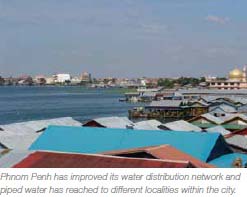 Operations were also made more efficient by
overhauling the old infrastructure, and streamlining
the billing process, among a slew of new measures
(See Box 3: Making everyone pay). Because of these
reforms, the PPWSA has widened its distribution
network from serving 40% of Phnom Penh in
1993 to over 90% in 2009 with clean, affordable
water. Other improvements include establishing a
complete consumer database, reducing NRW to
less than 6%, improving collections, metering all of
the utility's water supply coverage, and introducing
24x7 water supply (See Table 2: Then and Now).
Operations were also made more efficient by
overhauling the old infrastructure, and streamlining
the billing process, among a slew of new measures
(See Box 3: Making everyone pay). Because of these
reforms, the PPWSA has widened its distribution
network from serving 40% of Phnom Penh in
1993 to over 90% in 2009 with clean, affordable
water. Other improvements include establishing a
complete consumer database, reducing NRW to
less than 6%, improving collections, metering all of
the utility's water supply coverage, and introducing
24x7 water supply (See Table 2: Then and Now).

 Before reforms were initiated, most Phnom Penh
residents, including politicians, army officers,
government employees, and even PPWSA staff
members did not pay for their water usage. Of
the water piped from PPWSA reservoirs, 72%
disappeared without ever being paid for.
Before reforms were initiated, most Phnom Penh
residents, including politicians, army officers,
government employees, and even PPWSA staff
members did not pay for their water usage. Of
the water piped from PPWSA reservoirs, 72%
disappeared without ever being paid for.
When the PPWSA reforms project was
inaugurated, the Prime Minister made a public
statement asking everyone including government
employees to pay their water bills. The new DG
reiterated this directive and made bill payment
mandatory for all PPWSA employees. This
allowed the PPWSA to initiate a process to bill
the public. There was some resistance to this, but
the management of PPWSA did not panic and ultimately government officials, PPWSA staff members and other
consumers started paying. By this time metering and piped networks began to function, and hence if a consumer
failed to pay the bill, the water supply was disconnected after a notice was served. It was reported in 1993, that
PPWSA staff members were selling illegal connections for 1,000 USD per connection. To combat corruption and
nepotism within PPWSA, salaries were increased. Those who reported incidences of illegal connections received
concessions in their bills.
The lessons to be learnt from PPWSA are not a panacea to be replicated, but these reforms can be a set of guiding references while undertaking reforms. This publication discusses the changes that were undertaken within PPWSA.

3 | Enabling Environment: Policies, Funds and Tariffs
3.1 Policy changes and governmental support
PPWSA is a state-owned enterprise operating under commercial law. Previously, PPWSA was under the
jurisdiction of the Interior Ministry and dependent upon the Municipality of Phnom Penh and its governor.
In February 1996, the Government of Cambodia issued its first Socio-economic Development Plan (1996-
2000) which accorded a high priority to water and sanitation. The Plan's long-term objectives were for the
water utilities to become self-sustaining commercial entities. In 1996, initial steps were taken to improve the
sector's institutional framework. These comprised:
• A law providing for greater autonomy of public enterprises;
• the establishment of PPWSA as a public enterprise, mandated to operate according to commercial
practices; and
• in recognition of the need to rationalize sector institutions, the creation, by the government, of a
coordinating committee (CC) for the water and sanitation sector.
The CC recommended a long-term national strategy for sustainable and cost-effective urban water supply
and sanitation. This plan allocated 83.2 million USD for water supply and 12.3 million USD for sanitation
for Phnom Penh. This total allocation of 95.5 million USD to the city represented nearly 60% of the national
funding for the water supply and sanitation sectors.
PPWSA was granted independent financial status in 1997, in line with a 1996 decree. A law was passed in
1996 entitled Law on the General Status of Public Enterprises (No. 0696/13), which provided for the very
first time in the country a new legal framework for operation, management and supervision of all public
enterprises. The institutions became legally independent and gained financial autonomy though they were
placed under the supervision of a Government Ministry (tutelage), which consists of the Ministry of Industry,
Ministry of Mines and Energy and the Ministry of Finance.
Among the important requirements of the decree were the following.
• PPWSA must organize, manage, and operate all its activities independently in accordance with
commercial business requirements (Article 4)
• PPWSA could have an independent salary and incentive package for its staff, subject to approval by its
Board of Directors (Article 101)
• The General Director has the authority to hire and dismiss staff (Article 14)
• The General Director must submit to the Board of Directors an annual plan each year before the 1st of
October of each year, which must include (Article 20)
- Investment and financing plans
- Operational budget
- Price of water and other services to ensure that total revenue can adequately cover its operational
expenses
- State financial support through subsidies to PPWSA in case of losses in its public services delivery
The General Director is appointed for a three-year period but can be reappointed to any number of additional
terms thereafter. The General Director is appointed by the Prime Minister, after receiving nomination from
the tutelage ministries.
PPWSA prepares an annual investment plan which has to be approved by the Board of Directors and the
tutelage ministries.
3.2 Donor support
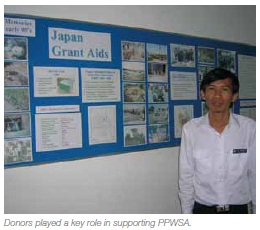 The massive turnaround within PPWSA management and services was made possible through significant donor
involvement. The Japan International Co-operation Agency (JICA) has been a major donor since 1991. When
urgent rehabilitation of the treatment plants was needed, the Cambodian government requested assistance from
the Japanese government to rehabilitate the systems. Aid also came from France, and together, the French and
the Japanese provided 5.2 million USD to rehabilitate Phnom Penh's water supply systems. JICA, in collaboration
with Japanese water operators, trained PPWSA employees in O&M capacity. Engineers from Kitakyusyu and
Yokohama municipality participated in this non-profit technical transfer for over three years. There was also a
technical assistance project by UNDP and the World
Bank to support capacity building in terms of training,
skills development and the conduct of some studies.
ADB supported water supply and drainage projects.
In 1997, PPWSA achieved financial sustainability and
started moving towards profitability. After this, donor
agencies shifted from grant-making to sanctioning
loans (See Table 3: Fund flows). PPWSA has
recently repaid its WB and ADB loans and recently
received one direct loan from Agence Française de
Développement (AFD). The WB loan, made after
service cost recovery had been reached, was paid
back in four years before the period of maturity.
One key reason for PPWSA's success relates to
sourcing their funding from donor agencies and not
being dependent on the government. Independence
allowed the utility freedom to innovate and distanced
it from political pressures.
The massive turnaround within PPWSA management and services was made possible through significant donor
involvement. The Japan International Co-operation Agency (JICA) has been a major donor since 1991. When
urgent rehabilitation of the treatment plants was needed, the Cambodian government requested assistance from
the Japanese government to rehabilitate the systems. Aid also came from France, and together, the French and
the Japanese provided 5.2 million USD to rehabilitate Phnom Penh's water supply systems. JICA, in collaboration
with Japanese water operators, trained PPWSA employees in O&M capacity. Engineers from Kitakyusyu and
Yokohama municipality participated in this non-profit technical transfer for over three years. There was also a
technical assistance project by UNDP and the World
Bank to support capacity building in terms of training,
skills development and the conduct of some studies.
ADB supported water supply and drainage projects.
In 1997, PPWSA achieved financial sustainability and
started moving towards profitability. After this, donor
agencies shifted from grant-making to sanctioning
loans (See Table 3: Fund flows). PPWSA has
recently repaid its WB and ADB loans and recently
received one direct loan from Agence Française de
Développement (AFD). The WB loan, made after
service cost recovery had been reached, was paid
back in four years before the period of maturity.
One key reason for PPWSA's success relates to
sourcing their funding from donor agencies and not
being dependent on the government. Independence
allowed the utility freedom to innovate and distanced
it from political pressures.

The Japanese government, which has been involved from the beginning, provided grants to PPWSA for
two master plans and feasibility studies, which included a future water development plan for the Phnom
Penh water supply system. The Japanese government also agreed to carry out the study to develop both
master plans. The first master plan study was prepared until 2010, and it turned out to be very important
and useful, serving as a road map for the PPWSA. The Plan was developed in close consultation with the
utility's management, and thus was acceptable to management, with the plan becoming the "blue print"
for development for the utility for subsequent years. All the projects supported by other donors had to fit in
properly with this framework, as well as comply with its overall philosophy. A new second Master Plan that
covers the period 2011-2020 has also been prepared with JICA support.
Other major donors who provided financial and technical support to PPWSA from 1997 include the ADB
and the World Bank. The support however, came in the form of loans to the PPWSA instead of grants, as
was the case for the initial financial support. The World Bank advised on the institutional arrangements,
which resulted in the greater autonomy for PPWSA. The resultant law created a Coordinating Committee for
Water & Sanitation and restructured water tariffs. In 1997, a credit for urban water supply in Phnom Penh
and Sihanoukville was obtained through the Bank. The technical assistance was for a national strategy and
policy framework, which consisted of a national policy on water supplies and the same for urban sanitation.
A second wave of World Bank aid for Cambodia was funding for the Provincial & Peri-Urban Water &
Sanitation Project in 2003. A part of the funds went to PPWSA who utilized them for the peri-urban areas.
PPWSA did receive other technical assistance from the Australian government under a twinning arrangement
between PPWSA and two Australian utilities. Similarly, through the operation of the Loi Oudin in France,
through which local finances in France can be used to help improve services in developing countries, a
partnership was established with the city of Paris that generated funds for subsidising the poor's water
needs. If PPWSA had been dependent on government funds, then the chances of losing autonomy would
have been higher. Financial assurances from other sources have led to greater sustainability. Because of its
significant achievements, the government also accepted this procedure.
Every year, audits on PPWSA's financial transactions are carried out by international auditors. According to the latest audited statement from PPWSA's auditors, Price Waterhouse Coopers (2009), PPWSA's operating revenue for the 2008 financial year was 21.9 million USD, out of which it made a profit of 7.3 million USD. PPWSA is one of the few publicly managed water utilities in the developing world whose net profits have increased since 1993 and have consistently paid income taxes (See Chart 2: Rising profits).

The main components of PPWSA's operating costs include electricity (44.97%) and chemicals for water treatment (10.73%), costs over which PPWSA has no control. Electricity costs are dictated by Electricité du Cambodge, and the chemical costs are determined by the world market prices. Salaries, wages and allowances for the staff account for another 32.16% of the annual expenditure.
3.4 Tariffs
The inherited water tariff by the utility was far too low to generate the necessary revenue. PPWSA had to increase tariff to cover operational costs. To avoid registering a big hike in the water tariff, PPWSA proposed to have a three-step increase in the water tariff over a period of seven years, along with service improvement. With strong support from the donors and commitment from the Government of Cambodia, particularly the Prime Minister and the Governor of Phnom Penh, the first step increase was achieved in 1997 and the second step in 2001. After that, PPWSA did not need to push for the third step, as its revenue had already fully covered all its costs. This was basically due to the higher collection ratio and the drop in the NRW that preceded tariff increases. The initial tariff plan was proposed by the ADB and adopted by PPWSA. The increase in the tariff was carefully planned. First, a socio-economic survey of the water supply situation was carried out for the city of Phnom Penh. This survey collected information on how much consumers were paying for water from other vendors, and what were likely to be their reactions if these vendors were replaced by supply from the PPWSA. This survey showed the willingness and capability of the consumers to pay a higher tariff for a vastly improved service.
 The tariff is different for domestic and commercial
connections. In 1984, the first tariff was set at
0.04 USD or 166 Riel/m³. This changed in 1993,
and the tariff structure was separated for domestic
and commercial purposes, with the domestic tariff
remaining same while the commercial tariff was fixed
at 0.13 USD or 515 Riel/m³. The tariff was revised
in 1996 and again in 2001. The first block tariff was
established in 1997 which has been revised and is
still being applied (See Chart 3: Tariff structure). The
tariff for government departments is seperate.
The PPWSA water tariff is progressive in nature,
and revising this is a difficult process. This requires
a request from PPWSA to the designated ministry of
tutelage and requires the final approval of the Prime
Minister. The tariff is based on the National Water Policy and is calculated based on total expenses, i.e.
O&M costs including depreciation of assets. PPWSA recovers all costs from the tariff except land costs, as
they keep rising. The value of assets is revised every five years.
The tariff is different for domestic and commercial
connections. In 1984, the first tariff was set at
0.04 USD or 166 Riel/m³. This changed in 1993,
and the tariff structure was separated for domestic
and commercial purposes, with the domestic tariff
remaining same while the commercial tariff was fixed
at 0.13 USD or 515 Riel/m³. The tariff was revised
in 1996 and again in 2001. The first block tariff was
established in 1997 which has been revised and is
still being applied (See Chart 3: Tariff structure). The
tariff for government departments is seperate.
The PPWSA water tariff is progressive in nature,
and revising this is a difficult process. This requires
a request from PPWSA to the designated ministry of
tutelage and requires the final approval of the Prime
Minister. The tariff is based on the National Water Policy and is calculated based on total expenses, i.e.
O&M costs including depreciation of assets. PPWSA recovers all costs from the tariff except land costs, as
they keep rising. The value of assets is revised every five years.

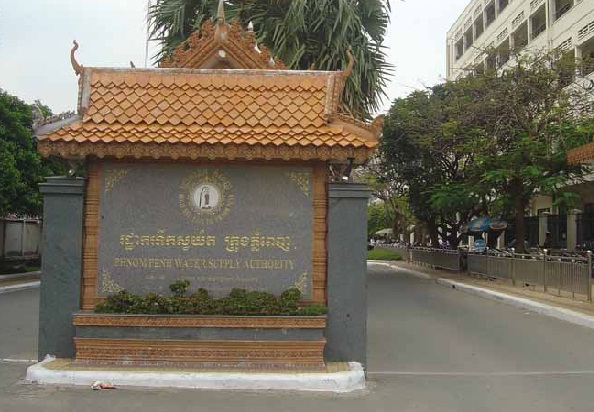
4 | PPWSA: Internal Reforms
4.1 Departments
Before 1993, PPWSA was run as a government department with no administrative, operational and financial
autonomy. It was an integral part of the Municipality of Phnom Penh and was under the control of the
governor of the city. It needed continuous municipal authorization for all its operational expenditures, which
was a time-consuming process. Revenues earned by the PPWSA were consolidated with general municipal
funds, and thus there was absolutely no incentive for PPWSA to innovate or strive to be profitable. The
institution had only three technicians who could connect water meters, and the cost of connecting water
meters was exceedingly high, around 150 USD per meter to 1,000 USD (the current cost is 100 USD per
meter). The meter readers and bill collectors were illiterate and often kept the money they collected.
After 1993, PPWSA was overhauled, and a gradual reform process with changes in organizational structure
was initiated. Now, PPWSA is broadly divided into five line departments with a separate training department
and a secretariat directly reporting to the Assistant General Director (AGD). A separate inspection unit is
directly handled by the DG. There is a carefully designed horizontal and vertical structure in place with the
DG at the helm and with a Board of Directors above the DG (see Chart 4: PPWSA organogram). The five
line departments are:
• Planning and Technical Department: responsible for all planning, procurement and projects
• Production and Distribution Department: responsible for potable water production from raw water and its
distribution across the city via networks
• Commercial Department: responsible for customer billing, connections, and customer relations
• Administration, Human Resources and Securities: handles all administrative and staff-related issues like
office logistics, recruitment, and evaluation
• Finance Department: handles all finance-related matters
There are a total of nearly 604 personnel within PPWSA, including the DG and staff from securities. There
are 464 male employees, while the number of women employees stands at 85. PPWSA personnel can be
broken up into 547 staff members, 16 trainees and 33 contract employees. There are 18 managers for the
line departments. The number of staff per 1,000 connections stood at 3.5 in 2008, having come down from
22 in 1993, making PPWSA among the most efficient at a global level.
There have been major organizational restructurings, and various departments went through major
changes. Some units were closed, while new units were formed and expanded. The overall PPWSA
organizational evolution is a gradual process and is being implemented over time (See Chart 5: Example from
Commercial Department). For example, the Commercial Department has evolved over three stages.
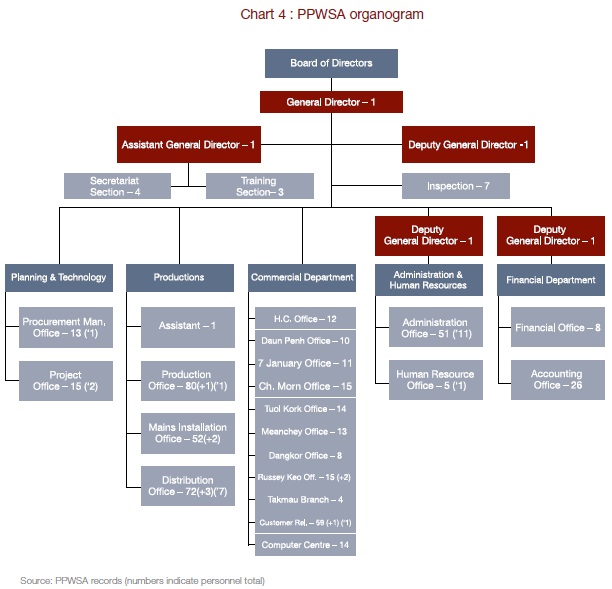
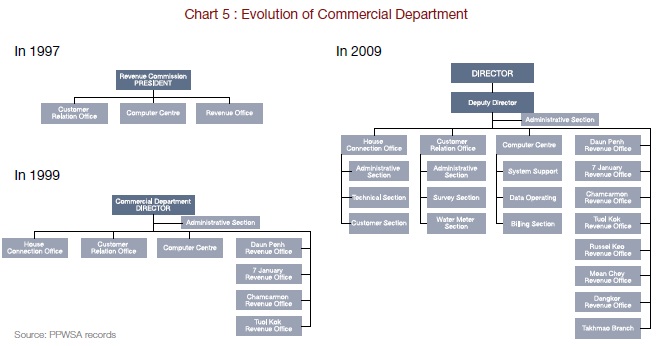
4.2 Planning and accountability
Each department is responsible for its own planning and accountability. Overall it is a decentralized process,
and every department has to produce its own annual plan. The planning department guides, formulates
and monitors the plans. Short-term plans are the responsibility of the departments, from which data is
collected by the planning department. Each department is responsible for implementing, monitoring and
reporting. They have to deliver quarterly and annual progress reports. In all review meetings, the director
of the line department has to report and also convey the problems faced within the department, suggest
remedies and make recommendations. SWOT analysis is conducted for each department. There is a final
evaluation based on achievements against plans.
Employees are accountable for their output. There is a set structure for evaluation that defines:
• Organizational structure
• Job structure
• Responsibilities and tasks
• Performance related to plans
• Achieved tasks
• Reasons for not achieving
Inspection is conducted by the PPWSA Board. The director of the PPWSA board is the head of the
Comptroller's office, while there are also representatives from the tutelage ministries. In total there are five
representatives from the government and two from PPWSA. While the DG is part of the Board, the other
PPWSA representative is chosen by voting within PPWSA. The selected member can serve for a period
of three years. Currently, an internal control department is currently being created. There is an established
Statement of Purpose, and it is respected.

PPWSA hires staff for various job activities ranging from field workers to managers to technicians. A fieldlevel
worker has to have atleast high school education. Technical and managerial staff are recruited from
universities. Often, students from universities who are hired as trainees based on performance may be
offered a permanent position.
Sometimes instead of hiring external candidates, staff members are transferred from one department
to another. Volunteers can be enlisted for a period of six months without any salary, but are provided
an opportunity to upgrade their skills. Based on their performance, they are recommended to HR by
the manager of the line department. The HR department conducts examinations for the volunteers, and
successful volunteers are hired on a contract basis. A volunteer who has failed the tests gets a three
months extension as a volunteer and then can again take the tests. The contract lasts six months, and
PPWSA pays a salary. After a period of six months, there is another examination and on passing, the person
is recruited as a trainee. After another six months, trainees write assignments on PPWSA and about their
job descriptions, after which they are selected as employees. For the purpose of easy identification, a dress
code exists for all employees. Field staff are differentiated from managerial staff by their uniforms.

PPWSA invests in their staff; incentives and bonuses are considered as important elements of this
investment. Wages in 1993 were meager, and this contributed to the high corruption level. In contrast, if a
staff member at a managerial position was paid 20 USD in 1993, by 2008, the salary has been increased
to 200 USD.
Employees receive overtime and bonuses at the end of a mission and at the end of the year. Profits
are shared with employees. Incentives are offered for many aspects of performance, e.g. secondment to
other water utilities in different provinces of Cambodia. A solidarity fund financed by employees allows for 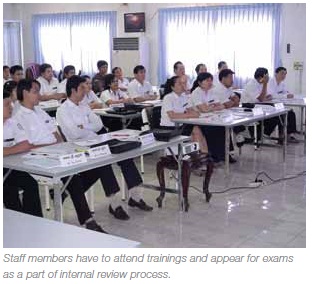 the provision of interest-free loans to the poorest
workers. The utility pays particular attention to staff
welfare and has created a retirement system for its
employees which is the first of its kind in Cambodia.
the provision of interest-free loans to the poorest
workers. The utility pays particular attention to staff
welfare and has created a retirement system for its
employees which is the first of its kind in Cambodia.
PPWSA evaluates its employees four times a year.
Line managers are responsible for evaluation and
are required to have face-to-face discussions with
staff members. There are different sets of evaluation
forms for:
• Section chiefs and assistant managers of offices;
• Office managers; and
• Staff from network operations.
Apart from incentives and evaluations, disciplinary actions are also an important element of PPWSA
management. There is a disciplinary committee under the HR department with the DG as head. If there is
a case of lack of discipline within any department, the director of that particular department refers it to the
HR department and to the DG. Disciplinary actions are dependent on employee status. An employee found
to be responsible for lack of discipline, then the person is penalized. Disciplinary steps can be as follows.
• First, there is a delay in salary increment
• Second, the employee's function is changed and salary increment is delayed by one year
• Third, the second step is repeated with a 15% deduction in salary
• Fourth, there is a 35% cut in salary and the employee is shifted to a different department
• Fifth, if there is still no rectification, the staff member is dismissed
On a rare occasion does the stage of dismissal arise.
If an employee is absent from duty for three continuous days without informing the management, then the
first level of penalty is imposed. Similarly, on further absence, subsequent levels of penalties are imposed.
Grievances can be communicated to their managers in writing. There is a complaint and grievance box
for staff members to raise their complaints. The DG personally goes through the complaints and tries to
address the issues.
4.5 Staff training
The PPWSA has a very active training department with a well-equipped training room along with training
material that is regularly updated. Training sessions are organized in-house. There are attendance registers
to ensure full participation during the training process. For external training, on receipt of letters of invitation,
staff members from relevant departments, depending on the type of training, are selected. External training
sessions are organized by donor agencies supporting PPWSA like JICA. Staff members get the opportunity
to visit other water utilities, too. PPWSA staff members have attended international trainings organized by
JICA, ADB, UNDP and the governments of Thailand and Australia, among others.
Within PPWSA, short training sessions are provided to staff, where external experts are
invited as guest lecturers. In 2008-2009, staff members attended about 24 small and large
sessions. According to the training department head, staff members go through positive
changes and pick up new skill sets during these workshops. Many of the training workshops are
tailored for specific departments, but there is some general training sessions related to information
technology, filing, administration, etc. For HR-related training, employees are sent outside. Apart from
training sessions, different departments are encouraged to share their experiences with each other.
A training committee consisting of senior employees from different departments determines the quality of
the training material and approves it. They are responsible for selecting the trainers and advise on improving
the overall training process.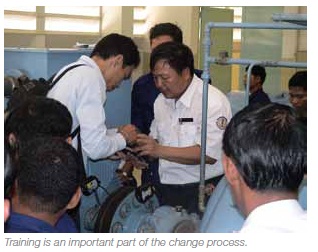
Training does not end with workshops. All personnel
attending training have to appear for exams after
the training sessions. They have to pass the exams
for performance appraisal. All staff members have
to take an annual exam which was initiated in 2006.
It is an important exam within PPWSA, and failure
in these exams result in salaries being not increased
during appraisal. On passing the exams, results
are evaluated along with performance during the
training period based on which salary is increased.
Occasionally, staff members are selected to attend
a Master's programme to universities within the
country and for short courses at foreign universities.
The courses that are attended by staff members are
often related to management, not technical issues
pertaining to water. For example, the Director of Human Resources and Administration was nominated by
PPWSA to attend a Master's programme on management at the Cambodian University of Specialization.
The PPWSA also undertakes training workshops for other water utilities, and many water utilities from across the region have participated. PPWSA employees have been invited as guest lecturers in workshops organized by JICA. An ADB-funded twinning arrangement between PPWSA and Viet Nam's Binh Duong Water Supply Sewerage & Environment Company Limited (BIWASE) identified priority areas for improvement of BIWASE operations, trained BIWASE personnel in priority areas of water supply operations, institutionalized a system of process benchmarking and monitoring measurable improvement in two or more areas of operations.
4.6 TransparencyPPWSA implements a policy of transparency. The utility produces and distributes progress reports and performance indicators on a regular basis. Every three months PPWSA's administrative council reviews results and priorities. Results are then transmitted and commented upon by the DG to all staff members. Every year the authority's accounts and procedures are subject to an audit carried out by an independent international auditor. Transparent procedures in turn foster government, civil society and donor confidence in the utility. Internally, a set of indicators are used to understand the overall performance and department level performance on a monthly basis. A total of 148 indicators are used for evaluation. Externally, data is shared with benchmarking organizations like Southeast Asian Water Utility Network5.
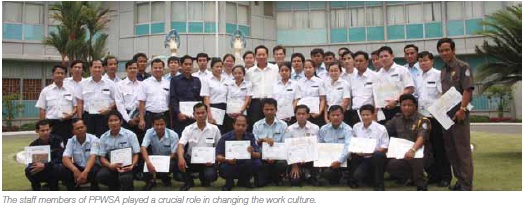
Box 4 : What does staff of PPWSA say?
Sar Davy, Team leader, Head of Cashier Department and Information Desk, employee since 1993
Sar Davy is responsible for registering complaints, providing information to customers and potential customers,
and directing complaints to relevant departments. Davy, who has been part of the reform process, believes that
her department's role is important as information-sharing with consumers is an important management aspect.
"By sharing information and listening to customer complaints, we help in reducing tension for the management, as
we control customer's anger." Before the whole CRO was established, relations between customers and PPWSA
were distant, but now the customer-PPWSA relationship has improved dramatically and the team can handle
grievances better.
Huot Sok Heng, Head of Training Section, employee since 2004
Huot Sok Heng, a graduate in management studies, joined PPWSA at a secretarial level. His skills were noticed
by the management, and he was shifted to the training unit. He underwent training in Japan and Viet Nam which
honed his skills. He believes that PPWSA received this recognition because of training for staff members. He says,
"Human Resources can only be developed through intense training, and this can change an institution."
S Kheng Lin, Director, Commercial Department, employee since 1993
S Kheng Lin, who has been with the PPWSA management since it was revamped, mentions that it was a very
difficult time in 1993. But due to the presence of a strong leader, Ek Sonn Chan, reforms could be undertaken.
New policies were formulated for each department, and everyone was encouraged to implement them. The whole
team rallied around the Director General and to affect the changes. The management has a disciplinary committee
that is strong and takes decisions to punish errant staff members as and when required, and it produced results.
Lin says, "The leaders must be the models, and when a leader is honest and is ready to sacrifice, every subordinate
follows the leader."
Roeun Nary, Head of Administration and Human Resources, employee since 1992
Roeun Nary, who handles human resources along with administration within the PPWSA, says that if all of the
staff works hard, then there will be further improvement, which helps in making wise decisions. She has been with
PPWSA from 1992 and spent a few years with the Commercial Department before moving to HR. The Director
General played a critical role in turning round the fate of the utility within one year. Most of the decisions taken have
been positive in nature. She says, "Staff in PPWSA are very happy. They work hard and are rewarded with good
salary and incentives."
Tan Bun Neth, Head of Phum Preh treatment plant, employee since 1992
Tan Bun Neth says that a lot has changed since 1992. A lot of the old machinery has been replaced, and all the
pump sets are 100% new. "The introduction of new technologies and machinery has made my job much easier,"
he says. He also feels that as demand has gone up, he is busier now than before, but O&M is more efficient now.
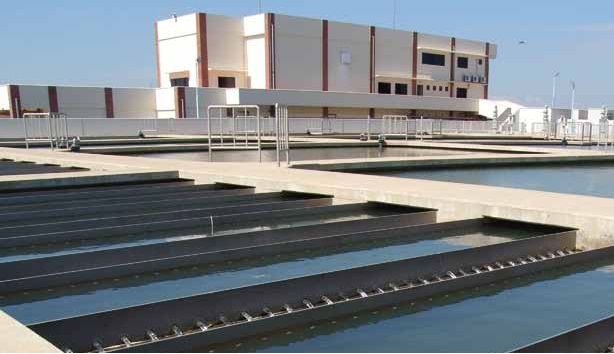
5 | PPWSA: Production and Operations
5.1 Infrastructure operation and maintenance
PPWSA owns three treatment plants located in different parts of the city, sourcing water from the rivers of Phnom Penh. The whole process is automated from the intake point in the network to the distribution points using a supervisory control and data acquisition (SCADA) system. The transmission and distribution network is 1,650 km long, consisting of pipeline networks reaching to the consumers' houses6. There are telephone and radio communication systems in each treatment plant that help to regulate the pumps, maintain pressure, identify leaks and solve them. Pressure is checked every hour. There are seasonal pressure drops, maximum water production is in June, which is the dry season, and then there is a gradual decrease in production. There are mechanical maintenance teams at each treatment plant, and a single electrical team at the central office. There are routine maintenance schedules. For example, there are programmes for monitoring water meters (See Box 5: Water meter maintenance programme) and leak detections (See Box 6: Leak detection process). After each check, an evaluation report is prepared. The procurement of equipment and fixing of problems is taken care of by the Production Department, and only costly equipment like pumps are referred to the DG. PPWSA pumps have been running smoothly for 10 years.
Customers are informed about any maintenance works to be undertaken. If a maintenance task requires more than an hour, then the task is carried out at night, but if takes a lesser time, like leak repairs, the works are carried out immediately.
Box 5 : Water meter maintenance programme
In the case of the water meter maintenance programme, periodic maintenance is undertaken as follows:
• Set up water meter control programme:
Every year for water meter with a diameter of 15 mm and 20 mm with Index ≥ 10,000 m³
Every 6 months for customers with a water meter diameter of ≥ 25 mm
Every 3 months for customers suspected of fraud
• Set up water meter cleaning programme at the same time with distribution pipe cleaning
• Set up water meter calibration principle
Box 6 : Leak detection process
PPWSA has designed a leak detection process specific to their requirements and available resources. The
Leak Detection Campaign started in 1996 with the support of an external expert. PPWSA uses a telemeter
system at the Production Department, which detects high leakages and illegal connections in different
zones. There are 58 sub-zones that have a local leak detection system. There is a 24-hour team present
for leak repairs, and response time is two hours after the complaint is registered. Each repair has to have a
follow-up report. The leak detection and repair teams work in tandem. Metering has been structured under a
District Metering Area with each district having one team. The number of personnel in one team is dependent
on the number of customers being served in one district. There are two engineers in a leak detection team.
Each leakage control team is offered incentives based on a percentage of reduction of leaks. There is a NRW
committee that reviews all leakage works. They measure the ratio at the beginning and at the end of the year. If
the team performs inefficiently, however, then it receives a penalty. This structure allows for a certain amount of
competitiveness among the leak detection teams. Each staff member in the leak detection team has signed a
contract for incentives and penalties.
This system has allowed significant improvements in NRW. In 2000, the NRW ratio was 32, but the current NRW
ratio is less than 6, a massive improvement that makes it one of the best levels among water utilities in the world
(See Chart 6: Falling NRW).


5.2 Infrastructural and technical changes
In 1993, the overall process of running the water utility was manual and based on old, non-digitized technologies. There was no computerized monitoring, and it was difficult to detect leakages or monitor a large coverage area. Finances and administrative filing systems were manual and involved tremendous amounts of paperwork. Once the change process started, information technology was given priority, and most of the works, both technical and administrative, were computerized. Process control was shifted to the SCADA system, where a computer system monitors and controls the process. In 2003, an accounting information system was introduced to hande the finances of PPWSA. Staff members were trained to
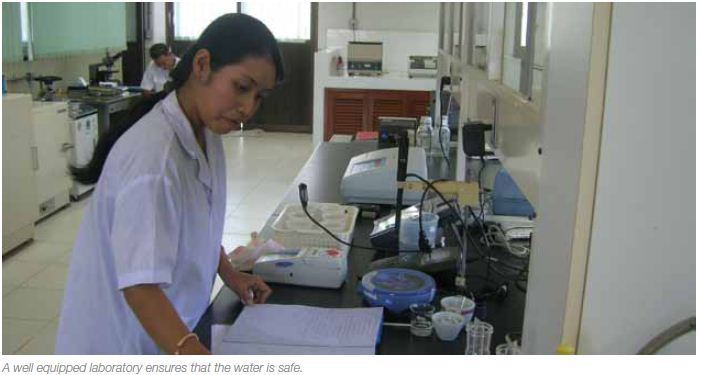
operate the new system, which was received with enthusiasm after initial doubts. Water treatment plants are semi-automated and that has reduced the number of staff needed to run them. PPWSA has even restored a 1963 water treatment plant. There were 1,945 underground tanks in Phnom Penh, over which the PPWSA had no control. They have now been closed down7.
Overall in the production unit, the utility has:
• Metered all its connections and upgraded from Class B to more accurate Class C water meters
• Replaced old pipes
• Eliminated underground tanks
• Divided the distribution network into zones, each equipped with a pressure and flow rate measuring system
• Installed a data transmitter that monitors online data for analyzing big leaks in the system

7 Illegal underground tanks were used by households, and it was very difficult to monitor the amount of water consumed or control the quality of water in such tanks, which numerous households were using. After the PPWSA decided to determine the magnitude of the problem posed by these underground tanks using a survey conducted in 1994, it made a policy decision to close them as quickly as possible and to provide every household that had depended on them with water through individual house connections. When this was not possible for a few specific cases, a caretaker was nominated for each tank and was provided with a meter. The caretaker was considered to be a local vendor-cum-retailer and had to pay the PPWSA for the total water consumption from the tank at the prevailing domestic rate. He then collected the funds from the consumers, which gave him some net income after paying for the water to the PPWSA.
5.3 Future directionsPPWSA aims to work towards the Millennium Development Goals and is currently supplying safe water to 90% of the urban population. PPWSA is planning to sustain this until at least 2030. Phnom Penh's population is expected to increase to 2.3 million by 2020 and 3 million by 2034. The current infrastructure and production capacity will not be enough to sustain this future demand. PPWSA has started working towards increasing production capacity by implementing a Stage II Priority Project. It is also expected that the PPWSA will become the Phnom Penh Metropolitan Water Supplier by 2020, as coverage will reach districts in other provinces. The current 450 km2 coverage is expected to reach 1,500 km2. The 2005-2020 Master Plan includes a five year business plan in which investment in the water supply sector has been identified.


6 | PPWSA: Customer Service and Community Contacts
6.1 Connection and reconnection procedure
Customers can pay for connection on site instead of at the main office. The poor living in slums are given
certain privileges. For example, they are allowed to pay in installments within 10 to 20 months during which
interest is charged. There is a 30% subsidy for the poor that is cross-subsidized by others. The cost
of a single residential connection is 140 USD. In slum areas, where the people are mostly not literate,
PPWSA team members go there to explain the process and also to help in filling out the forms.
Internally, the Commercial Department is responsible for connections. Once the application for a new
connection reaches the Commercial Department, the chief of the Technical Section is informed and then
an appointment for measurement is made. The measurement agent goes to the customers' premises and
after the relevant measurements are calculated, prints a connection invoice and collects the connection
fee from the customer. A date is fixed for the connection, and the field staffs visit to make the connection.
A connection takes about a week, but in the case of slums the period is about 10 to 15 days. This delay
is due to procedural requirements regarding installments that the customers from low income households
require8. The matter has to be referred to the Fund Management Committee, which makes a decision.
Within three days, the new customer's database is created. A connection team for each zone has 10
members led by a team leader from PPWSA, while the connection labourers are contract workers. The
team leader is responsible for recruitment of the labourers.

Previously water was sold by water vendors at an exorbitant rate, but with PPWSA's supply reaching the customers, customers' water bills were reduced drastically. Some of the peri-urban areas, however, are still buying water from local vendors who source water from PPWSA. This is due to the lack of road and distribution infrastructure which hampers PPWSA's extension plans. These vendors are termed 'wholesellers' by PPWSA (See Box 7: Whole-sellers' story). Many of the customers are not happy with this arrangement and want PPWSA connection. This shows that water costs less when one accesses it from the water utility network in comparison with private vendors, and consumer satisfaction is also higher (See Box 8: Consumers speak).
Box 7 : Whole-sellers' story
 PPWSA calls them whole-sellers. They are the water
vendors of Phnom Penh who supply water to the
people who do not have access to PPWSA water due
to the lack of a piped network. Their service area is
mostly located on the peri-urban areas of the city, and
their consumer base includes the poor and industrial
labourers. These whole-sellers, however, have a link
with PPWSA as they buy water from PPWSA at the
pre-determined PPWSA commercial rate and sell at a
price determined by the whole-seller.
PPWSA calls them whole-sellers. They are the water
vendors of Phnom Penh who supply water to the
people who do not have access to PPWSA water due
to the lack of a piped network. Their service area is
mostly located on the peri-urban areas of the city, and
their consumer base includes the poor and industrial
labourers. These whole-sellers, however, have a link
with PPWSA as they buy water from PPWSA at the
pre-determined PPWSA commercial rate and sell at a
price determined by the whole-seller.
Chom Chao commune located in Dang Kor district
near the international airport of Phnom Penh is
predominantly an industrial zone. Most of the residents
here are workers of the adjacent factories. The colonies
do not have paved roads, making it difficult for PPWSA
to lay their distribution network. The whole-seller steps
in here. There are a total of 110 families in the locality
and there are two whole-sellers who sell at the same
price. Soum Ean is one such whole-seller who sells water in Chom Chan commune to 77 households. In an
average month, he buys about 800 m³/month (rate is 1500 Riel per m³ which is the commercial rate) and makes
a bi-monthly payment of 790 USD. He sells the water at the rate of 0.6 USD (2500 Riels) and on an average, in a
month he earns about 300 USD. The whole-seller is responsible for installing meter at own cost and supplies water
to customers mostly via PVC pipes or sometimes small tankers. PPWSA signs a contract with the whole-seller
under which vendors like Ean can sell water to people at a price of their choice.
Ean, who was a middle man in land dealings, shifted to the water business in 2008 because he finds it more
profitable. Initially, he had four connections from PPWSA but as PPWSA changed its connection rules reducing it
to one connection per consumer, he now has one connection only.
Most of Ean's customers are, however, not happy and prefer to have a direct PPWSA connection. Customers
like Kao Vhouch Lang, who works in the nearby textile factory lament that they are paying much higher than the
PPWSA rates and they do not get regular water supply.
Box 8 : Consumers speak
Bodeng building, Tonle Bassan: There are nearly 100 families living in this squatter block, which the authorities
consider illegal.
Kim Sacy; resident since 1999, four-person family
Kim Sacy has no access to a PPWSA connection because she could not afford the connection fee. She buys water
at 0.84 USD or 3,500 Riel per cubic metre (m3) from a water vendor who gets water from PPWSA and sells to
residents without access to a PPWSA connection. In Sacy's neighbourhood, there are four water vendors who also
reside there. They have legal connections from PPWSA, and they also sell water to the residents who do not have
access to PPWSA connection. Water is pumped by the vendors to Sacy's house, and they have 24 hour access
to water. Meters have been installed too. Houses located in the upper stories of the buildings have problems with
the pumping of water.
Sacy, her entire family of four members, and their grocery shop use about 11 m3 of water per month. Sacy and her
neighbours find the quality of water good, but they are hesitant to use the water for drinking. They either boil the
water or buy 20 litre water bottles which costs 1 USD or about 4,000 Riel. They consume about six to eight bottles
of water per month in the rainy season, while the number increases to 10 during the dry season. One reason
people are using bottled water is the lack of the odour that is prevalent in PPWSA's water due to chlorination. Now,
Sacy has enough money and has applied for a PPWSA connection which will cost her 10.92 USD or 45,000 Riel.
Sacy believes that public water is cheaper than private water.
Chim Kosal, resident since 1999, four-person family
Chim Kosal and her family of four members are also dependent on a private vendor for water. They use about 3 to
4 m³ of water per month. They have a storage tank which is connected to the vendors' pipeline. They are interested
in getting connected to the PPWSA line but are hesitating as there are rumours that their colony (slum settlement)
maybe removed from its current location because the authorities consider it illegal. Their application for an electrical
connection was rejected.
Kosal's family does not drink bottled water as they detected the presence of sediments in the water. They boil
water for drinking. She considers that the water vendors are a mafia as they are the richer families of the slum.
All vendors have an arrangement by which they allocate water. People have to control the usage of pumps and
meters. A meter costs 5 USD, which Kosal and others who get water from vendors have to buy themselves.
Chay Sarom, resident since 1982, four-person family
Being a long-time resident, Chay Sarom has seen the transformation and has shifted from dependence on private
water vendors to PPWSA. Sarom and her family of four depended on water vendors previously, but from 2005,
they are customers of PPWSA. They paid about 10 USD or 40,000 Riel for the PPWSA connection. They store
water in a tank. Sarom says that buying water from the private vendors was expensive and the family limited their
water usage to 5 to 7 m³ per month, whereas now they are using much more water and paying less. Also, payment
to private vendors had to be made every month, but payment to PPWSA can be made once in two months. Apart
from the PPWSA connection fee, she had to pay for a meter and pump which cost about 100 USD or 400,000
Riel. The payment was made to PPWSA in installments. Sarom and her family has never uses bottled water and
boil the PPWSA water for drinking. They do not face any health problems.
Village 8 has eight separate villages and is a mixed area of poor and middle class residents.
EM Mong, village chief, resident since 1998, 10-person family
EM Mong is 70 and is the village chief. He has a big family of 10 members and so depends on both PPWSA and
rainwater. He is paying about 7.5 USD or 30,000 Riel every two months to PPWSA for the consumed water, and
to save on the bill, he has installed a rainwater harvesting system. He is paying about 0.13 USD or 550 Riel per m³.
The price has increased over the past 10 years from 0.08 USD or 350 Riel. Children in Mong's family use bottled
water for drinking while adults use boiled water.
Village 16 is a squatter colony near a railway track.
Soy Najy, resident since 1999, seven-person family
Soy Najy received her PPWSA connection in 2005. Previously she was paying about 2,000 Riel for one 20-litre
drum of water to vendors and was using about three drums daily. She has a sewing and tailoring shop that requires
more water. In one month, she was paying 150,000 Riel or 37.5 USD for water. In 2005, residents of the locality
urged PPWSA to extend their network to their squatter colony, which the PPWSA did. Now, Najy pays 15,000 Riel
or 4 USD per month for water – that is, ten times less than before. It has helped her to reduce costs tremendously.
Before the PPWSA connection, they did not have 24-hour water connection and used to receive water only at night
because the slum is located at a higher elevation. In 2008, the situation changed as PPWSA improved its network,
and they now have a 24-7 water connection.

Out of 152,000 connections, there are 14,000 poor families getting direct access to PPWSA piped water. PPWSA's programme called Clean Water for the Poor launched in 2000 helped to increase connections. This was possible after the NRW level dropped, thus leading to more water in the supply network, and the total revenue was enough to cover the cost (See Box 9: Poor consumers' access to water). This helped in reducing the burden on women and children, allowing them to have more time to assist in community affairs. Besides that, clean water could also prevent many diseases. Regarding commercial, institutional and industrial connections, the customers have to approach the PPWSA office.
Box 9 : Poor consumers' access to water
To bring the poor into the coverage network, PPWSA initiated a campaign called Clean Water for the Poor. This
was initiated in 1999 when PPWSA had total revenue higher than the costs and the NRW dropped, resulting in
more water in the network. Under this campaign, poor communities are provided with clean water via installment
payments and subsidies. They get a subsidy in terms of house connection and also consumption fees. Regarding
the consumption fee, the progressive water tariff helps. The average tariff is about 0.24 USD per m³, which is well
within the average family's purchasing power. A poor family's average monthly water bill is about 1 USD for 7 m³
of water and accounts for around 4% of such a family's monthly income of around 25 USD on average. Water bills
declined by a factor of 5-6, for a vastly improved service for the city's poor. Private water vendors have disappeared
from the PPWSA area, and people, including the poor, are willingly paying a higher tariff.
The process of getting the poor connected went through a lot of experiments. The first experiment determined
specific communities of poor people, who then elected community representatives to whom PPWSA sold water,
and then resold it to their respective communities at a tariff recommended by PPWSA. The system did not perform
as expected because the community representatives mostly sold water to the poor people at 10-20 times the
subsidized rate.9
In March 1998, PPWSA received a soft loan from the World Bank, a part of which was earmarked for the
provision of clean water to the poor. PPWSA stopped using the community representatives and started supplying
water to the poor households directly. This arrangement did not work very well, primarily because the necessary
information was not properly disseminated to the poor households. In 2000, two work teams were formed
for better dissemination of information. They were also responsible for implementing the entire programme. It
improved the number of water connections to the poor families to 474 that year. In 2001, the PPWSA carried out
a survey of the views of the households that had received the connections and also those that did not about its
"water supply for the poor" programme. This survey identified two fundamental problems:
1. Poor families found it financially difficult to pay connection fees in 10 monthly installments, and
2. People were still not aware of the programme and its potential benefits.
At present, because of a grant by the International Development Association (IDA) and depending on the poverty
levels, poor households are entitled to receive subsidies of 30%, 50%, 70% or 100% of the connection fee,
depending upon their financial conditions. These conditions are jointly evaluated by a committee of PPWSA and
the local commune representatives. In addition, those households that consume a maximum of 7 m3/month, had
to pay only 60% of the real cost of providing water. This new policy has helped poor households to save between
31 USD and 91 USD. As a result of these improvements in the pro-poor policies, the number of poor households
that were connected to the system has steadily increased each year.
On non-payment of charges, PPWSA has a policy to deal with these situations. If a customer does not pay the amount due, a warning is conveyed to the customers with a 15 days deadline. Even after the first warning, if the customer fails to clear the dues, a second note is sent informing that within this date, if the payments are not made, then the customer will be disconnected from the network. To get back the connection, the customer has to pay the outstanding amount and also pay a penalty of 1% of the amount per day along with a reconnection fee of 14.50 USD or 60,000 Riels. On further default or delay in payment, the reconnection fee increases to 24 USD or 100,000 Riels. After this, the reconnection is made. Such customer details get automatically updated in the database.
6.2 Consumer billing and grievancesWithin the department of PPWSA known as the Cashier Department, the billing and consumer desk is
responsible for collecting charges and filing consumer complaints, and also acts as an information desk.
The department has its office located within the PPWSA complex where people come to pay their bills.
Recently, four collection and complaint registration kiosks have been opened in four zonal branches within
the city. There is one bill collector and one complaint registration officer manning the desks.
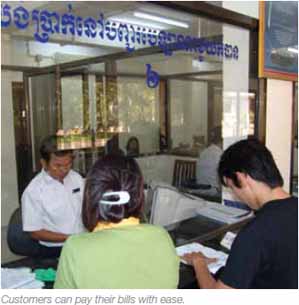 Bills are issued by the Commercial Department, whose staff members observe the meter reading and then
send readings to the Computer Department. The printed bills go to the Revenue Department, which issues
the bills to the customers. Bills are issued bi-monthly. The collection ratio is high as all bill collectors are
given an incentive or penalty. A higher percentage of collection of water bills leads to a higher payment for
collectors. If a collector receives less than 97% of the bills for three consecutive billing periods, then the
concerned collector is penalized or removed.
Bills are issued by the Commercial Department, whose staff members observe the meter reading and then
send readings to the Computer Department. The printed bills go to the Revenue Department, which issues
the bills to the customers. Bills are issued bi-monthly. The collection ratio is high as all bill collectors are
given an incentive or penalty. A higher percentage of collection of water bills leads to a higher payment for
collectors. If a collector receives less than 97% of the bills for three consecutive billing periods, then the
concerned collector is penalized or removed.
Regarding filing of complaints by consumers,
people can lodge complaints by visiting the
complaints registration desk or making a phone
call. Staff members working on this desk say that
most people come in person to make a complaint,
and it helps in understanding the problem better.
There are two people handling the desk that has a
list of complaint categories, which are filed under
the relevant category and then forwarded to the
concerned line department. Complaint categories
include issues relating to water consumption,
connections, metering and leakage among others.
Accordingly, the relevant complaint is directed to the
line department. For instance, if there is a problem
related to water leakage, then the matter is reported
to the Team Leader of the metering and leak
detection unit. Following this, the line department
takes the necessary action. If the consumers are
not satisfied with the answers or if there are issues
that need actual departmental handling, then the
consumers are taken to the concerned department.

The customer complaints are also sent to the data entry department for the purpose of records. On an
average, the PPWSA office complaints desk receives about 30 to 50 complaints per day. The desk also
provides information as requested by customers through various booklets and leaflets. Field staff is also
provided with information leaflets to share information with customers.
There is a customer database which helps in identifying the customer code and other details including
queries and remarks section. The database was created in 1994, and in 2002, PPWSA shifted to a more
updated database system called NAVISION. The database is very up-to-date. PPWSA launched a massive
customer survey to identify customers and create a database. It took one year with 100 PPWSA staff
members visiting residents of Phnom Penh to build the database10.
6.3 Awareness campaign and community contact
PPWSA initiated an information campaign with direct interaction with the consumers to make people aware
about the procedure to obtain new connections, on water tariffs, subsidies, the penalty system regarding
illegal water connection, non-payment of bills, quality of water, grievances and redressal, and other servicerelated
issues. Information leaflets include material on the process of water production, treatment and
distribution to assure the consumers about safety aspects. PPWSA staff members also demonstrate the
safety of the water by drinking it in front of the consumers. Household handling of water is also part of the
campaign. The process for making an application for water supply is also explained. The PPWSA website is
regularly updated with the latest information. There is an information desk which also receives complaints.
The head of the information desk is invited to all PPWSA meetings and is updated on various departmental
changes by the management.
For accessing local communities, PPWSA contacts the community leaders via the local commune who in
turn informs the customers, and a date and venue is decided for the awareness campaign session. There
is a list of criteria to identify the poor, and PPWSA takes help from local NGOs to identify poor households.
NGOs also help during the process of laying pipe lines among poor communities.

7 | Conclusion
This case illustrates that a public sector utility can implement a management approach more akin to
that of a private sector company based on results and incentives. The success of PPWSA is a result of
several factors including a General Director with sufficient vision and leadership to push through a culture
of change, a desire for change at the local political level, sufficient autonomy to be able to implement
reforms as well as donor backing and shared objectives between line ministries, employees and donors.
The culture of change, implemented by PPWSA, focused first and foremost on employees, particularly
on education, motivation and, when necessary, sanctions. Clear and transparent operating procedures
mean that employees know where they stand. The utility's regular publication of performance indicators
and activity reports is a part of this transparent approach and demonstrates the importance placed on
accountability and results. Massive improvements in operational efficiency were made by an internally
driven set of incentives, penalties and disciplines, and a high emphasis on training. The utility has not only
generated change within the company but also among consumers and civil society by building an awareness
campaign and interactive sessions with PPWSA staff members. In addition, PPWSA's implementation of
the programme "Water for the Poor" aims to ensure that even those who cannot afford to pay the full cost
still get access to clean water. One of the traditional obstacles to extending coverage, namely tariffs below
operational costs, has been largely overcome, and the imaginative use of the revolving fund has helped
with transitional problems for poor consumers11. Consumers were informed about water tariff, connection
procedure, billing, and complaint procedures with the help of local communes, which helped to build a
positive relationship between the service provider and consumers.
Covenants with International Financial Institutions (IFIs) were used as guides to improve the water utility,
but these covenants need to be relevant to local situations. The government explicitly made this financial
commitment to both the ADB and WB when it sought loans from these two institutions for modernizing and
restructuring PPWSA and for rehabilitation of its old infrastructure and construction of new ones. The reform
worked in an internally generated fashion with local leadership, but the role of donors was very important in
terms of technical assistance and access to finance. The availability of finance from IFIs actually strengthened
the autonomy of the municipal service, because it made it less dependant on central government.
The strategy of cost recovery was implemented not only by increasing tariffs but also by focussing on billing
rates (the proportion of customers that receive a bill) and collection rates (the proportion of bills that are
actually paid). The successful accomplishment of these plans led to less reliance than anticipated on tariff
increases, making the third of three planned price increases unnecessary. This reduced the price obstacles
for the poor to manageable proportions. The strategy of cost recovery was also successful in reinforcing
autonomy.
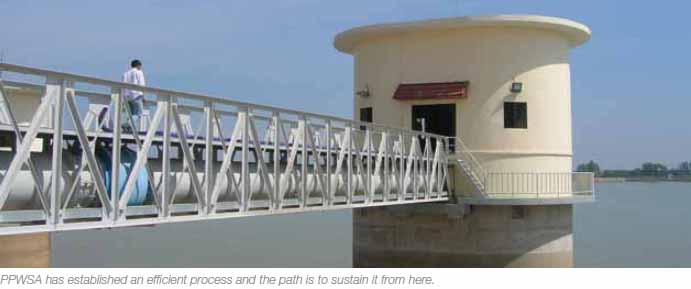
Though the PPWSA case is one of the best models for urban water management, one type of model will not be suitable for all developing countries. Developing countries are not homogeneous and are at different stages of economic, social, legal and institutional development. In addition, at least in terms of water supply, climatic conditions may vary quite significantly from one city to another, even within a single medium-tolarge size country, and the availability of water infrastructure is seldom uniform (See Box 10: Takeaways).
Box 10 : Takeaways
- • Appropriate policies with political support
- • Donor support and involvement
- • Proactive leadership
- • Autonomy
- • Motivated employees
- • Incentives for staff
- • Training of employees
- • Discipline among staff
- • Operational efficiency
- • Assets investment
- • Low NRW
- • Extensive coverage including the poor
- • High production
- • Adequate pressure in pipeline
- • Prompt maintenance
- • Tariff reforms
- • Cost recovery
- • Financial sustainability
- • Up-to-date database
- • Proactive grievance cell
- • Accurate billing process
- • High collection ratio
- • Customer outreach
- • Awareness generation
- • Inspection and auditing
- • Transparency
The challenges that remains for PPWSA are to complete its sewer service and bring it up to the degree of coverage of the drinking water service, and also to extend coverage to the outlying peri-urban areas where this has not yet been done.
References and Annexure
Refferences
Anon 2002, PPIAF Private Solutions for infrastructure in Cambodia, Public-Private Infrastructure Advisory
Facility (PPIAF), Washington DC
Anon 2003, Urbanization and urban water problems in Southeast Asia a case of unsustainable
development, Report # 25658, World Bank, Washington DC
Anon 2006, Water Sector Board, World Bank Water Feature story issue 6, Washington DC
Balanya B et al 2005, Reclaiming Public Water-Achievements, Struggles and Visions from Around the
World, Transnational Institute and Corporate Europe Observatory
Biswas A 2006, Water Management for Major Urban Centres, Water Resources Development, Vol. 22,
Routledge publications
Biswas et al 2009, Water Supply of Phnom Penh: A Most Remarkable Transformation – annexure, Third
World Centre, Atizapam, Mexico
Ek Sonn Chan 2009, Bringing Safe Water to Phnom Penh's City, Water Resources Development, Vol 25,
No 24, Routledge Publications
Winpenny J 2003, Financing water for All, Report of the World Panel on Financing Water Infrastructure,
Word Water Council, et al World Water Forum 2003. p.32
Low Kwai Sima and G. Balamuruganaa 2009, Institute for Advanced Studies, University of Malaya, Kuala
Lumpur, Malaysia
M. Kariuki, J. Shwartz & M. Schur 2006, Reaching unserved communities in Africa with basic services.
Gridlines No. 9, PPIAF
Master Plan of Phnom Penh by 2020-Chhay Rithisen, Huybrechts Eric, Office of the Urban Affair of the
Municipality of Phnom Penh, Kingdom of Cambodia,
http://www.phnompenh.gov.kh/english/Master_Plans/Master_Plan_By2020.htm
McIntosh A 2003, Asian Water Supplies-Reaching Urban Poor, Asian Development Bank and
International Water Association, Manila
References l 51
South East Asian Water Utilities Network, About SEAWUN,
http://www.adb.org/water/seawun/SEAWUN-about.asp
Warick and Cann 2006, Going Public-Southern Solutions to the Global Water Crisis, World Development
Movement, London
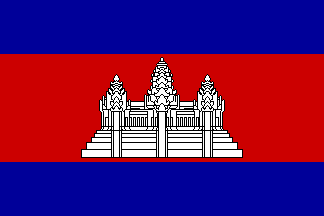
 ភាសាអង់គ្លេស
ភាសាអង់គ្លេស
